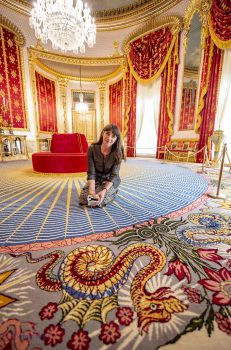Art historian reveals the transformation of one of Brighton's most regal rooms
By: Stephanie Allen
Last updated: Thursday, 4 October 2018

Photo by Simon Dack

A University of Sussex art historian has curated an exhibition detailing the restoration of Brighton Pavilion’s magnificent Saloon room, drawing on her PhD research at the University of Sussex to do so.
Dr Alexandra Loske spent six years working on her thesis, juggling research with a newborn baby, and finally receiving her PhD in July 2014. Since then she has become a part-time curator at the Royal Pavilion, curating exhibitions on a number of topics many of which have had strong links back to her Sussex PhD including ‘Regency Colour and Beyond 1785–1850’, and now ‘A Royal Room Restored: The Story of the Saloon Restoration’.
Alexandra said: “The Saloon room is a breath-taking space within the Pavilion with incredibly rich colours. The minute visitors walk in, they’re greeted by an explosion of colour from the deep crimson to the regal gold, in combination with silver, which is very rare. The Saloon room was decorated for King George IV in 1823 and the dazzling silver, gold and crimson was intended to reflect his status as King.
“These colours, and especially the use of silver in historic interiors, formed a big part of my PhD thesis so it’s been really exciting to not only see the restoration of the Saloon, but to have been able to curate an exhibition about its transformation so members of the public can get a glimpse into what goes on behind the scenes.
“I was asked to put the exhibition together in a relatively short space of time, so my PhD research undoubtedly helped in being able to do that.
“For obvious reasons most of the original ornaments from the Saloon could not be displayed in the exhibition, as most were put back into the room, but a few precious ones are included, for example the tiniest piece of original crimson silk. I also chose a few related objects that show techniques that were part of the creation and restoration of the room.
"A favourite of mine is a Regency dragon, elaborately carved and gilded, and possibly from the Long Gallery. It has lost much of his gilding, but this means you can see how he was made 200 years ago. I paired him with a rare and delicate drawing by the designer of the room, Robert Jones, which includes dragons he envisaged for the Saloon.
"Nearby are jars of so-called ‘skewings’, excess flakes of gold and silver from the restoration, alongside the actual tools used by our conservation team.”
‘A Royal Room Restored’ tells the story of the Saloon restoration and allows members of the public to see a number of behind the scenes artefacts, from artist’s designs for the carpet (which is a reproduction of the original circular Axminster carpet), to photos of restorers at work throughout different stages of the project.
The exhibition runs until March 2019.
